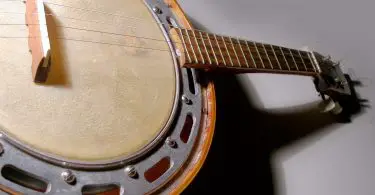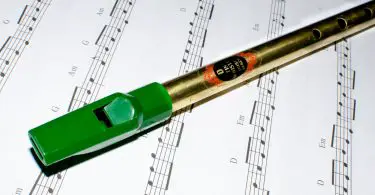I love weird instruments, and as a result of extended study, I’ve become a multi-instrumentalist. Simply put, I can’t get enough of the different tonalities that you can get with differing instruments, which is why these unique instruments really interest me. Take a few minutes and read more about the instruments that I’ll be covering in this guide – you’re guaranteed to learn something new in a fun way!
There are so many instruments out there that you can learn. If you love thrumming tones, you can drum, play bass, or even learn to play the tuba. For those that like a higher tonality, there are also a ton of mainstream instruments from which to choose, but what if you want to play a more unique instrument?
Fortunately, there are hundreds, if not thousands of unique-sounding and unique-looking instruments to select from on the market. Have you ever heard of a fluba? What about the octobass? Each of these unique instruments will be featured in this guide as well as a bit of information about what makes them truly different.
1) Hornucopian Dronepipe
The hornucopian dronepipe has a unique design that almost looks biomechanical. In fact, the dronepipe is a fairly new instrument that is actually 3D-printed so that it has a truly unique shaping. The hornucopian dronepipe wraps around your body and is a variant of the Australian didgeridoo but has a sound that’s wholly unique. Completing sustained tones with this instrument is relatively easy, and for those looking to provide long fills, there’s no better modern instrument for the task.
Also, the curved design of the dronepipe is definitely a great conversation-starter – the instrument almost looks snakelike, and the acoustic output will seldom require any amplification. This is thanks to the fact that the instrument has a sound-producing design that produces tones that can easily fill an auditorium. Throughout the body are several large sound holes, which combine for a very resonant sound, and since the average hornucopian dronepipe is almost the size of a person, you can imagine how much sound it outputs. Despite this, this brasswind instrument isn’t overwhelmingly heavy, so check your local music store so that you can try one for yourself.
2) Hyperbass Flute
If you want to really wow your listeners, the bassy and deeply resonant hyperbass flute will almost always do the job. This instrument is the largest in the flute family, and it is also the one with the deepest bass register. While many consider the contrabass flute to be the deepest, the tones generated by the hyperbass can be more than an octave deeper. Additionally, whereas someone could theoretically carry their contrabass to a performance, bringing in a Hyperbass may require an extra set of hands.
In fact, to a casual observer, the hyperbass could definitely be confused with standard home piping, but the variety of keys and brackets marks this instrument as a member of the flute family. When listening to the deep rumble of the hyperbass, you might even think that it produces sounds that almost sound digital, but when paired with certain genres of music like jazz, it’s easy to see where this unique instrument could sound very complimentary.
3) Octobass
The octobass, which is also called the octobasse, is an instrument that has more than a 150-year-old history. Crafted in 1850, the octobass was designed by Jean Baptiste Vuillaume and is so large that a standard instrumentalist can’t play the instrument like a standard bass. Instead, the octobass requires a platform so that the player can reach the levers, which are positioned at the top of the body. These levers serve a very practical purpose; since the instrument is so large, fretting is nearly impossible, so the levers close capo-like arms across the three strings, which allows you to fret while you play.
While it is shorter than standard bass bows, the bow on the instrument is much larger and heavier, and the horsehair portion is almost two inches wide. When it comes to sound output, the octobass emits some tones that are so low that humans cannot hear them, so the majority of the sounds produced will undoubtedly be incredibly bassy. In fact, when I had a chance to listen to this instrument, I was amazed at how much this instrument’s sound resonated at some of the deepest frequencies I’ve ever heard.
Invented by Henry Dagg, who is a sound engineer for the BBC, the sharpsicord is a unique instrument that is also called the pin barrel harp because it works by spinning barrels that are perforated with pins. With the sharpsicord, a music maker can screw pins into the perforated cylinder to produce music. Each pin is raised enough to pluck a string, so as the barrel spins, multiple notes on the chromatic scale are played, which means that the music must be charted beforehand. Still, this is an instrument that can truly produce some ethereal sounds that sound very classic despite having only been invented in 2011.
4) Sharpsicord
As a result of its unique design, the sharpsicord will always be in tune, and unlike other musical instruments, it doesn’t necessarily require any actual playing skill to produce music – it just takes rigorous planning. Having said that, to operate the instrument, you have to turn a crank, which can be a bit tiring. For those that are more hands-on, there is a keyboard attached to the instrument for a more traditional harpsichord experience.
5) Digi Fonf
This instrument, the digi fonf, has origins in Romania and is a fairly recent invention compared to some of the other instruments in this article. This woodwind instrument has a design that’s fairly similar to the flute, but instead of manipulating the tone via keys, you use your index finger to alter the sound coming out of the instrument. Pressing the tip of this finger into this hole allows you to perform sustains, tremolos, and staccato sound effects. As you might expect, this Romanian instrument is very compact and easy to carry with you, which makes it a go-to for those that like to perform impromptu music.
Insofar as complexity, the instrument definitely has something of a learning curve, especially considering that playing it requires a bit of precision. That being said, this is an excellent instrument for anyone that likes to play music that might be performed in festivals and family get-togethers. One of my favorite features of the digi fonf is its trilling sound, which might remind some of the notes of an ocarina.
6) Cello Horn
I know what you’re thinking, “But, the cello and the horn are totally different instruments!” While it may seem a strange combination, the cello horn, which is also called the strohcello, is a beautiful-sounding instrument that incorporates the resonance of a cello with the bombastic volumes that are famously produced by brass instruments. The horn portion of this instrument works something like the f-holes in a traditional cello – in other words, whereas the resonance of the strings is enhanced within the body of the cello, the horn section of the instrument projects the sound and expands on it significantly so that you have a completely different aural experience.
This string/brass hybrid has origins in the 1930s, but few people have ever heard of its existence. Despite this, this is an excellent instrument for orchestras, for private parties, or to just play for friends. It’s very easy to fill an auditorium with the sound of this instrument, so be aware that it’s definitely something that could wake the neighbors.
7) Theremin
The theremin is responsible for many of the ethereal sound effects that were made famous in the horror and sci-fi movies and shows of the 1950s and 60s. The theremin uses electronics to create a ghostly sound, and while you’re playing it, the point is to never actually touch the instrument due to the fact that the instrumentalist used his or her hands and an electromagnetic field to create the unique sound. The theremin is one of the first electronic instruments and has origins in the very early 20th century, and it is definitely one of the more unique instruments invented in the modern era.
There are two antennas in the theremin – a loop antenna that controls the volume and a standard antenna that controls the pitch. As the hand approaches the upright antenna, the pitch gets higher, so control of your hands near to the antenna is important for each performance. One of the most interesting aspects of the theremin, in my opinion, is the fact that you have to craft your music by ear rather than by memory.
8) Fluba
While you’d be forgiven for thinking that the fluba is a combination of the flute and the tuba, it is actually the hybrid invention of Jim Self that combines the flugelhorn with the latter instrument. For those that aren’t familiar with Jim’s work, he’s been the tubist for John Williams for over 25 years and famously performed the “talking” sequence in “Close Encounters of the Third Kind.” Jim considers the fluba to be a “tuba-sized flugelhorn” and has pioneered this unique instrument’s music.
When it comes to sound output, this unique instrument sounds something like a more mellow-sounding tuba. In some aspects, this instrument is also a bit brighter than a standard tuba, which means it occupies a fairly unique tonal space. If this is the type of instrument that might pique your interest, understand that it is rather large, so it’ll take some getting used to. On the other hand, it’s a very attractive instrument, and its design is so unique that it will easily be a conversation-starter.
9) Yaybahar
To be honest, I’ve never heard something quite as unique as the yaybahar. This instrument has so much resonance that it almost sounds like it would be at home in a space opera like 2001: A Space Odyssey. In fact, when you hear the yaybahar play, it almost emulates the sound of multiple instruments being played in tandem, which can sound very ethereal. From a design perspective, the yaybahar is a very large instrument that uses a bow for the sound generation. In general, you won’t be able to play this on the fly because it’s relative unwieldy to carry around. That being said, it’s relatively lightweight, so setup won’t be too difficult if you opt to play this with an orchestra in an auditorium.
One of the coolest features of this instrument is the fact that you can fret like a stringed instrument, but it has such a large sound that there’s nothing like it in that category. As a result, you’ll feel very acomplished once you achieve some mastery.
10) Chapman Stick
The first instrument that I learned on was the acoustic guitar, and for this reason, I typically end up playing the guitar the most out of any instrument. Recently, I’ve really taken a liking to the 12-string guitar because of its resonance. The Chapman stick is something like a 12-string, but whereas a 12-string has a standard-sized neck, the Chapman has a much longer neck and is played by tapping and fretting rather than plucking. As a result, this instrument sounds very unique. The strings on the Chapman are also spaced out differently than a 12-string, which means that you can play more unique notes with one.
The instrument has origins in the 1970 and was created by Emmett Chapman. It’s often called a stick because most variations don’t have the wide body of a guitar, so it looks very stick-like. If you’re looking for a bit of versatility, this is a good choice due to the fact that it can produce bass or standard guitar-esque tones.
11) Hydraulphone
For any personal taste, there’s an instrument. The hydraulophone uses water to produce music, and it’s certainly unique, especially if you prefer a wet and wild experience. Constructed of a sizeable curved tube, the hydraulophone can use reeds or be completely reedless when it produces music. To play it, water must be continuously pumped through the instrument, and you’ll have to touch various sound holes throughout the instrument in order to produce notes. While playing the hydraulophone, it’s common for water to squirt out in front of the hyrdaulophonist, which is why placement of the instrument is essential.
The overall sound profile of this instrument may remind some of a keyboard, but there are also tonal similarities to woodwind instruments as well. Overall, the hydraulophone is an instrument that can be worth the time learning, but remember that it’s on the larger side of things, which means that it’s designed more for organized performances than impromptu affairs.
12) Zeusaphone
As you might expect from the name, the Zeusaphone is an instrument that harnesses the power of electricity. Based entirely off of Tesla coil technology, the Zeusaphone is one part spectacle, one part musical performance because it produces coils of electricity that also make music. How does it generate sound? Well, each coil of electricity vibrates the air, which causes the electronic-sounding tones that the Zeusaphone is famous for. The instrument can produce sound waves up to 900Hz, which is near the kilohertz range of hearing and means that there’s quite a lot of range on this instrument.
Operators of the Zeusaphone will typically have to compose the music being played on the instrument beforehand, and any “performances” between the coils is typically just for entertainment purposes, but learning to play music on this instrument is fairly simple and fun for most. Setup of the coils can be fairly straightforward, but since you’re working with high-voltage devices, it’s important to note that you will have to execute due diligence to ensure safety when using the Zeusaphone.
13) Glass Harmonica
The glass harmonica, which is also known as the armonica, is an instrument that was first created by Benjamin Franklin. Unlike traditional harmonicas, it is effectively several different glass bowls that are combined, filled with water, and laid on their side so that the entire instrument can spin. As it spins, you run your fingers along the glass to create sounds. For the best sounds, you will need to have wet fingers that are slightly covered with chalk. The sounds that this instrument can create are unlike any other that you have heard, but it is also quite a beautiful experience. Some even say that the music from this instrument sounds like singing from beyond the grave.
During the 18th century, it was believed that playing this instrument would cause one to go mad, but the real reason that this instrument is so unique is that the tones that it creates are between 1000 and 4000 hertz, which makes it hard to decipher where the sounds are actually coming from.
14) Double Contrabass Flute
Though this instrument may look strange at first, when you take a closer look at it, you will notice that it is quite similar to a concert flute in design. The main difference is the size of the double contrabass flute and the fact that it is bent in a few locations so that it is easier for the musician to play. In total, this instrument has over 18 feet of tubing, so it would be nearly impossible to play without it being bent so that it can be played in an upright position.
This flute actually has a very low range that is three octaves lower than a concert flute and one octave lower than the tones that you would hear from a cello or a similar instrument. Even though the keys are spread across the entire instrument, your hands will be positioned relatively close together so that it is easier to play.
15) Hang Drum
Upon first look at the hang drum, it will look like a beat up wok or steel pan that has a few dents in it, but this unique shape can create some amazing percussion sounds that resemble not only the sound of steel drums but the sounds of bells and harps as well. Because of the shape of this instrument and the dents that are in the material, the tone that you create will be much softer than a drum.
To play this instrument, you will need to place it over your lap with the hollow part of the drum facing your legs. This will create a hole where the sound of the instrument can resonate. To create the drum sound, you tap it around the dimples, but if you want more of a bell sound, you will need to tap the hang drum with your hands where the dimples are located. The dimples may look to be randomly placed, but they are actually placed in specific locations that are going to create the most unique sounds.
16) Balalaika
The first thing that you will notice about the balalaika is that it is a stringed instrument that has a triangular shape. This instrument, which originated in Russia, is one that is typically designed with three strings, but there are models that you can find with four, five, or even six strings. This stringed instrument is very similar to the banjo, but when more strings are added to it, the sounds that it can create will more closely resemble that of a guitar.
The balalaika is an instrument that can vary in size; there are five different options that you can purchase that range from a small 20 inches long to nearly six feet in length. Most of the music that you will hear from this instrument is folk music because this type of music will sound great with three strings. It dates back to as early as the 1500s where it was used as an instrument to entertain the ruling class. It soon became a common household instrument that represented unity within the country and the world.
17) Jaw’s Harp
This is an instrument that is not often considered because it is very limited in the sound that it can make. In fact, the pitch that you can create will not change, just the harmonics of the sound that you create can differ based on the way that you position your mouth around it. To play this instrument, you simply hold your mouth apart just enough to place your fingers between your teeth. Then, you take the instrument and place it loosely in your mouth so that the sound that it creates resonates. If you are holding it too tightly, the sound will be muffled when you pluck the tongue to make it vibrate. The tongue is often made from metal, but sometimes it is made out of bamboo.
If you are unsure of the sound that this instrument can create, think back to the cartoons that you enjoyed as a child. The “boing” sound that this instrument creates can even still be heard in cartoons today.
18) Alphorn
The alphorn is a long wooden horn that can often be heard in the Swiss Alps, hence the name. This horn is typically about eight to ten feet in length, which can make it awkward to play. In fact, the turn of the horn is positioned on the ground several feet away from the person playing the instrument so that they can easily blow into it. This instrument makes a lovely sound that is often used to communicate with the herd and nearby herdsmen. It was also used as a signification that it was time to gather the herd and take part in evening prayer.
Depending on the length of the instrument, the sound that you hear from it will vary. There are no finger holes or keys on this instrument, so it will not have a large range. The F-sharp alphorn is the most common, and it can be heard in a lot of classical music as well as some jazz of today.
19) Didgeridoo
If you enjoy playing wood instruments, the didgeridoo is an excellent option that originated in Northern Australia. It is crafted from hollow wood; any wood can be used, but most of the modern didgeridoos of today are made from bamboo, eucalyptus, and agave. This instrument is often considered to be a percussion instrument because it makes a droning sound, but if you change the positioning of your lips and the air that you put into the instrument as you play it, the sounds can vary quite a bit.
This is a great instrument to have as background music when you want to meditate, and to create the traditional didgeridoo sound, all you need to do is relax the muscles in your face and blow air through your lips as you vibrate them. If you want to create a bass sound, this is a great instrument that can be used to amplify the sound so that it can be heard above other instruments.
20) Nyckelharpa
This is a unique instrument from Sweden that has been around for over 600 years. In fact, it is known as one of the oldest instruments that you can still find today. It is a stringed instrument that resembles a modern guitar is some ways, but it has 16 different strings. There are melody strings on the nyckelharpa, drone strings, and resonance strings, and when combined with one or more of the 37 keys that are positioned under the strings, the music created by this instrument can reach three octaves. The keys act as your fingers would on a guitar fret, but since you would use a bow to play it, the strings are much more resonate.
Today, there are at least four different variations of this instrument that you can find, each of which have evolved from an earlier model. Over the years, keys and strings and keys have been added to the nyckelharpa to give it a wider range, but in general, the instrument is very similar to what it was centuries ago.
21) Conch
Have you ever seen someone play a beautiful conch shell by blowing into it like a trumpet? Well, in the South Pacific, conch music is commonly heard and associated with a daily call to prayer. The instrument does not need to be crafted, all you need to do is find a conch and clean any debris from the shell. These shells also vary in size, so each shell that you collect is not going to sound the same when air runs through it, but if played correctly, the sound can reach about two miles.
To give you an impression of the sound that this instrument can create, think back to the movie Alien that was released during the year 1979. The eerie sound that you hear in the background around the spaceship was made using a conch. To play the instrument, all you do is blow into the smaller end of the shell that is nearly encloses and put your hand in the large opening to mute the sounds that you create as you create music.
Final Thoughts
Now that you’ve had a chance to read about the 21 weird, unique-looking instruments that you can find on the market, go out and give one a try. While these aren’t the most mainstream instruments, you’re guaranteed to have fun learning to play one if you put the time in. Each of these can be found in various internet sources and even in your local music store. Whether it’s the classic didgeridoo or the naturally-occurring conch shell, there’s a lot of value in expanding your musical horizons. You’ll be amazed at the sounds that these unique instruments can produce.








Start the discussion at talk.hearthemusicplay.com